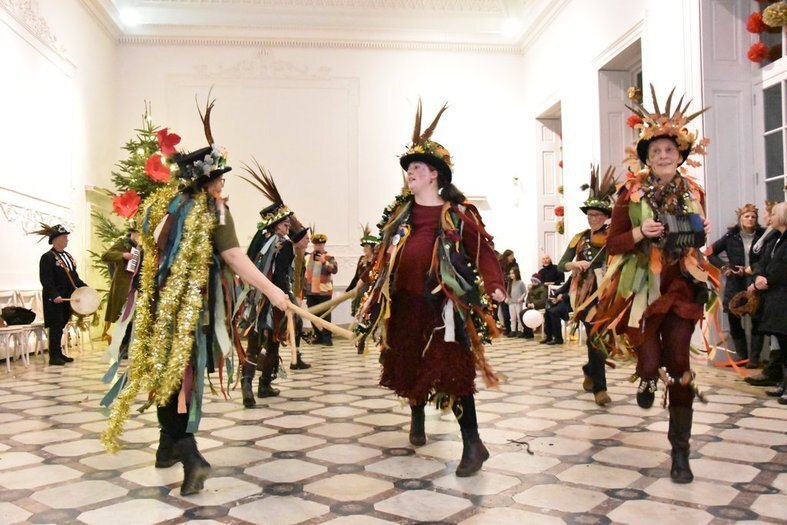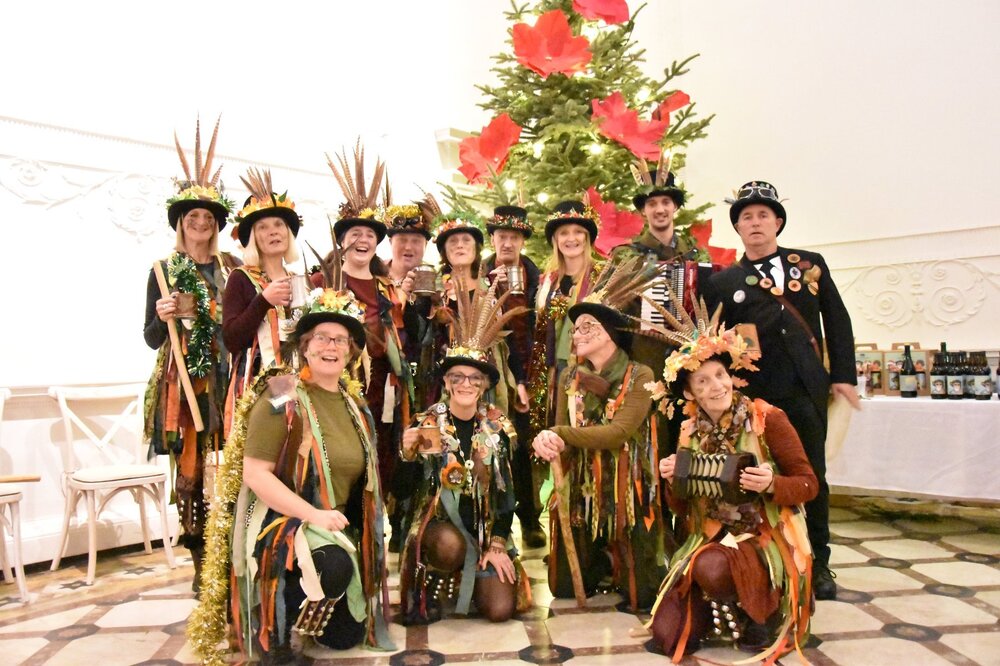-
Posts
226 -
Joined
-
Last visited
Posts posted by Kathryn Wheeler
-
-
Thanks! It would be nice to do more singing, if I could only remember the words!
-
1 hour ago, wunks said:
Exactly, even to the point of supplying the words to the melodies!
Darn, mine only supply melodies to others’ words. And is no use when I’ve forgotten words!
-
On 3/8/2024 at 3:10 AM, wunks said:
Concertinas are magical objects like a sorting hat. They know who you are and will invite you to play. They are playing you as you play them.
This is SO true. They come up with the tunes, too!
-
Two ways:
One end against left thigh (if I'm doing tricky things especially with my pinkie on the lower left side) - right side if right (I have a short little finger and it helps..)
or
Playing the anglo standing (e.g. for dancing/singing with a group) - in which case I'd like to say I play it more vertically, with the instrument over the elbows, but in practice it varies.. I also move it around more (unconsciously - I guess it just goes with the whole body movement).
-
It is brief (1 minute long), but it’s based on a longer video (that I also posted yesterday). YouTube Short videos have to be 1 minute maximum.
This is the original piece:
Yes, played on a Bb/F with a good few more buttons. It was played as if it was on a 20 though! No third row in the tune. In fact the piece it’s based on was originally written for one row!
Theres more information in the video description on YouTube
-
 2
2
-
-
51 minutes ago, Tiposx said:
Lovely. Your concertina has a really good tone on that piece.
Thankyou, that’s really useful to hear. I’ve not videoed this instrument before, so so it’s really helpful to have your feedback! -
Yes, I reckon!
This looks interesting:
-
 1
1
-
-
I've just tried my first YouTube Short video (it's only a minute long)
This is an improvisation on the introduction to On from Abberley, that I just posted. It didn't fit in with the video, and works on it's own.
-
 9
9
-
-
This is a tune for 20 buttons - in fact for much of it it’s for one row - but it was written whilst playing this unusual 32 button Bb/F instrument by David Leggett. No worries though - the tune works very well on a C/G and on a 20b.
-
 3
3
-
-
What an interesting discussion!
I tend to use flavour words, as these come to mind most readily. For example - a harsh violin E string I would describe as being sharp and lemony, or acidic, or stringent. The lower tones on a viola might be fudgey or chocolatey.
Regarding concertinas, I've played some that were too metallic sounding and others that were warm and rich (is that still flavour, or am I using a wider range of words?)
But saying this, since I studied acoustics I do use other terms like "this has too many higher overtones" (for harsh and bright).
Some concertinas have been excellent in terms of response and playability but have just a uniform sound I'd term "pure" (i.e. not enough soul or character...not emotionally complex enough?..that's quite an intangible thing to describe!) I wonder if it is related to pure in the acoustic sense i.e. not having lots of overtones and having a sound wave more like a sine wave.
I did do an acoustics project but it was on the medieval fiddle. It would be interesting to look at the acoustics of different concertinas and compare them i.e. do fourier analysis (look at what harmonics are present in the sound) to analyse the timbre.
-
Hi!
What else do I play?
Piano accordion - I've realised I don't really play it for folk, unless I'm accompanying. A lot of right hand chordal stuff, interesting harmonies, really using the sustain capabilities. Basically a portable keyboard/synth with a nice bass! Lots of pop influences. Good with singing.
Viola - chuggy rhythms, harmonies/countermelodies, double stopping, more soulful than my violin, which I'm not really using at the mo.
Medieval fiddle - love the potential of it for droning (bit like a hurdy gurdy) and the interesting tuning.
-
 2
2
-
-
Sorry I haven't responded to all your really interesting comments until now! It is fabulous to see someone doing Cotswold Morris with a concertina - all I've been doing so far is a simple Border step. I'm deep in Border country here, with little opportunity to try Cotswold.
And I haven't been in the set with other dancers (good point about sticks!) The only processing I have done is at festivals just playing whilst walking (and the dancer's did their thing).
I do very much like how the anglo is a natural for really getting the _feel_ of the dance step in its playing, if that makes sense.
-
I do this with my own music, certainly
-
I bet it had a different timbre too and stood out from the middle/bass ranges of those instruments
-
 1
1
-
-
Playing and dancing! Does anyone have any experience?I never set out to do it consciously, but whilst we were playing for a dance, recently, I ended up dancing at the same time. It's only a single step, but it's a start! It felt very natural indeed.I've seen some musicians dancing Cotswold jigs whilst playing a fiddle or melodeon and that looks pretty full-on! I'd love get a feel for Cotswold stepping and how that "feels" to play and move to, but there are no sides closer than 50 minutes away that I could dance with. We are definitely in the middle of deep deep Border country
 Holly is behind me, here, on fiddle. We were moving around, engaging with the audience and generally having a fun time.The concertina is well suited to dancing, I think, because it's relatively small and light. I need to think a bit more about what works and doesn't, musically, when dancing (and when playing standing up), but it's encouraging.This is at Compton Verney, the impressive 18th century building/art gallery a good hour or so east, in Warwickshire - Bow Brook Border Morris were dancing there as part of an early Wassail evening. Unusual for us to dance inside for a Wassail! (Some musicians were escorting the public around the trees outside too)It was quite a full-on performance, as we were the only side dancing and in between dances the musicians and those of us dancers who were also musicians, took a turn to play tunes. I did get to sing a couple of mid-wintery songs too. Revving up for Wassail season coming soon!
Holly is behind me, here, on fiddle. We were moving around, engaging with the audience and generally having a fun time.The concertina is well suited to dancing, I think, because it's relatively small and light. I need to think a bit more about what works and doesn't, musically, when dancing (and when playing standing up), but it's encouraging.This is at Compton Verney, the impressive 18th century building/art gallery a good hour or so east, in Warwickshire - Bow Brook Border Morris were dancing there as part of an early Wassail evening. Unusual for us to dance inside for a Wassail! (Some musicians were escorting the public around the trees outside too)It was quite a full-on performance, as we were the only side dancing and in between dances the musicians and those of us dancers who were also musicians, took a turn to play tunes. I did get to sing a couple of mid-wintery songs too. Revving up for Wassail season coming soon!-
 2
2
-
-
As you no doubt have, I find the C/G anglo right hand side particularly can sing out over the top of other instruments. I find that all the time playing live and when I've layered anglo with piano accordion. I've also found this with melodeons, which can be loud and dominant instruments. A fellow piano accordion playing friend, who also writes tunes, said that he'd thought the anglo would have got lost in with the piano accordion, resulting in a big sort of free-reed "mush". But he was surprised how distinct the timbre was.
Here's an example of anglo/piano accordion writing. This one only uses the anglo as a single-line melody/countermelody instrument. So, it's a simple way to start. The piano accordion has a lot more variation in how it plays and what role it takes when. Since then I've played with a piano accordion by using the anglo as a more rhythmic instrument and also playing smooth, interesting chords underneath a single line on the piano accordion. The trick with accordionists is that they often like to do everything on their instruments (I can say this, because I play it and know the urge!), so it can be hard to get them to pare things back. It's knowing when to take turns by doing single line melody, countermelody, when to do rhythmic jabs, when to play smooth washy synth-like chordal accompaniment. It's also knowing when you might overwhelm the other instrument - how to give it space.
-
 2
2
-
-
Hooray for non conventional things with no fixed rules - do whatever you feel like with them!
-
 2
2
-
 1
1
-
-
Just as you can get interesting chords and combinations of notes using certain patterns of frets on, say, a uke, you can have great fun exploring what interesting combinations of buttons sound good together on the anglo! And how that changes with bellow direction. It might be interesting to compare how the Anglo’s layout feels after the uke - what is challenging, what is transferable. And of course what you can do to add rhythm and movement with the two instruments.
It also depends what type of music you’re interested in having a go at on anglo
-
 1
1
-
-
I come up with pieces for 20 button anglo, often with a lot going on in both hands at the same time. Harmonies, countermelodies, imitation, melody sometimes in l hand with r hand accompaniment, as well as standard chordal stuff. So, a type of harmonic style playing.
Because of this I use a slightly non standard modification of the sort of notation Gary Coover uses, but with left hand fully notated on the same stave as right hand notes. Left hand notes have stems going down. Too much going on to do otherwise I’ve found.
Yes, used to using a lot of ledger lines if using the top end. I do go up there for effect (one piece in particular in one section springs to mind!)
I think the way the buttons lie under the fingers, the patterns that are produced and how that changes from push to pull is very important. In other words something that is idiomatic, anglo concertinistic. Of course this stuff is important whatever instrument you write for but maybe more so when the instrument has certain combinations that won’t work together and others that work like a dream.Another issue to consider is the rhythmic/articulation potential of the instrument - it’s capable of so much movement and drive. Or depending on your instrument and style of playing, great melodic flow. You can contrast flowing sections all in one direction with in and outy bits. But the flow depends on availability of notes in one direction. Because there are several options for certain notes, you have a choice of how to articulate using the choice of button/bellows direction. And of course how you use the bellows as well.
-
Scientific pitch notation, but also clarifying what middle C is to make it extra clear
-
13 hours ago, Leah Velleman said:
Obviously I don't get to decide where the thread goes.
But I'd like to put in one more little plea for the topic to be "When people modify tunes like this, how do they do it?"
(If you want to argue about 20 buttons vs 30, session keys vs transposing, or C/G boxes vs others... well, honestly, I don't think there is a right answer to those questions, because it all depends on what you play, with who, and why. But in any case, there's plenty of other threads about them.)
Hi Leah,It sounds like, like me, you’d find this a fascinating exercise as well as useful. I call it "embroidering around the C sharps".
It occurred to me that things were veering away from what you want to know and I’m sorry if I had any part in that.
If you’d like to chat about this using actual examples of a specific tune feel free to message me.
All I can say is what works for me in the situations I play in.
After a while it becomes almost second nature and you find yourself using work arounds that you’ve used before. So it can be hard to explain!
Also how I’d explain it depends on how much knowledge of music theory terms you already know. And how you learn tunes (by ear, from dots). Looks like dots are ok since you shared some sheet music.
- have a friend play the C sharp-ish section of tune slowly or play a YouTube video at a slower playback speed. Try out different things - be playful, open minded, don’t be afraid to make a terrible sound. Record yourself or get the reaction of a friend over which was the best option.
- sing the tune slowly whilst playing your concertina version. See if it goes (not everyone can do that but hey worth a try!)
- input the tricky bars into Musescore (which is free) or similar sheet music writing app/program. It can play it back to you. Input one of your ideas into another staff beneath so it plays at the same time. Does it sound good? Tweak it .. rinse and repeat
- Look at the function the C sharp has in the bar - is it part of a run up or down to another note? In which case we are going to have to get to that note in some other way. Does the note you’re going to have to be in the same octave?
Is there an underlying harmony of an A chord (A C# E) or A seventh (A C# E G) often used to lead back to a D at the end of a phrase. If so could you substitute one of those other chord notes.
Ideally try to come up with a workaround that fits the character of the piece and doesn’t stick out like a sore thumb.
Gosh there’s a lot more that could be said - maybe do research into writing countermelodies and harmonies if you want some tips eg contrary motion, using thirds or sixths. What’s appropriate for one style of music may not be for others though. eg in some traditions and in history it was the practice to play or sing different versions of the same tune at the same time (heterophony).
It’s far easier to work with an example and not have to put this stuff into words isn’t it!
-
I agree! No qualms except that it can make it tricky for others to join in or cause consternation when their favourite tune they love to join in with in a session isn’t in the key they’re used to or can cope with on their own instrument.
I’m used to having to transpose so often but would actually love to hear people play in some different keys. And I love thinking about how I might play in a trickier key.
-
I think trying to see what you can come up with, just using 20 buttons, in this key could be a fun, interesting and informative exercise - if you like that sort of thing of course! No surprise, but I love that sort of stuff! And who knows you might find you get into arranging pieces and writing stuff of your own through it.
Transposing is of course an option (and I do especially love that there is a related piece already in existence that is in a very suitable key) - but of course isn't much use if what you want to do is play with someone else e.g. in a session. (Of course it utterly depends on the culture of the particular sessions that you go to and whether it's ok to play anything other than the usual!)
It absolutely depends on what floats your boat at the end of the day

-
3 hours ago, Leah Velleman said:
The original thought that inspired this was "How on earth would you play Road to Lisdoonvarna without the C#," and I was getting nowhere just tweaking a note or two, but your approach seems like it could work. I'll do some tinkering and see where I get to.
I would say that I have no experience of playing Irish tunes or Irish styles of playing anglo, so it may be that my suggestions may not be deemed appropriate in this context nor welcome!
However, if I had to, I’d start by seeing if any of the Csharps are quick passing notes in runs eg B C# D quavers - if so you could try missing that sort out and for example substituting a quaver rest or holding the B for the extra quaver.





"Drive the Cold Winter Away", harmonic style tab for Anglo
in Tunes /Songs
Posted
Ah! This is one of my favourite winter songs!